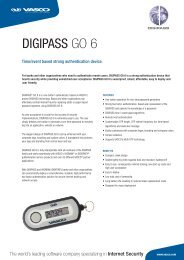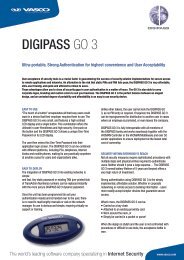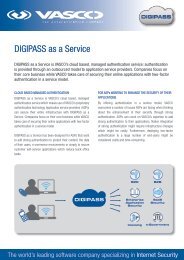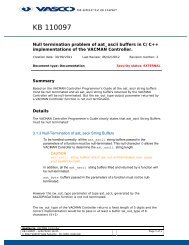Digipass Plug-In for SBR Administrator Reference - Vasco
Digipass Plug-In for SBR Administrator Reference - Vasco
Digipass Plug-In for SBR Administrator Reference - Vasco
You also want an ePaper? Increase the reach of your titles
YUMPU automatically turns print PDFs into web optimized ePapers that Google loves.
<strong>Digipass</strong> <strong>Plug</strong>-<strong>In</strong> <strong>for</strong> <strong>SBR</strong> <strong>Administrator</strong> <strong>Reference</strong> Configuration Settings<br />
11.1.7 ODBC Connection<br />
To view ODBC Database connection settings, open the Configuration GUI and click on the<br />
ODBC Connection tab. These settings will only be available if an ODBC database was<br />
selected as the data store during installation of <strong>Digipass</strong> <strong>Plug</strong>-<strong>In</strong> <strong>for</strong> <strong>SBR</strong>.<br />
11.1.7.1 Connect to an ODBC Database<br />
The database(s) used to store data required by <strong>Digipass</strong> <strong>Plug</strong>-<strong>In</strong> <strong>for</strong> <strong>SBR</strong> are listed in the ODBC<br />
Data Sources list on this tab.<br />
You may wish to add another database to this list if load-balancing or fail-over mechanisms<br />
need to be implemented.<br />
1. Click on the ODBC Connection tab.<br />
2. Click on the Add... button.<br />
3. The Data Source window will be displayed.<br />
4. Enter a display name <strong>for</strong> the data source (this will be used in data source lists in the<br />
Configuration GUI).<br />
5. Enter the name (DSN) of the ODBC data source.<br />
6. Enter the User ID and password of a database administrator account with permissions<br />
to read, write, create and delete <strong>Digipass</strong>-related data.<br />
7. Click on the Test Connection button.<br />
If the in<strong>for</strong>mation has been entered correctly, the test should be successful.<br />
8. Enter the minimum time the system should wait to reconnect to this data source (in<br />
seconds).<br />
9. Enter the maximum time the system should wait be<strong>for</strong>e retrying the connection.<br />
11.1.7.2 Connection Settings<br />
You may need to fine-tune database connection settings to increase per<strong>for</strong>mance of the<br />
database and the database driver in use, or if you are implementing load-balancing between<br />
two or more databases <strong>for</strong> the <strong>SBR</strong> <strong>Plug</strong>-<strong>In</strong>.<br />
1. Select a database from the list.<br />
2. Click on the Advanced Settings button.<br />
3. Enter the maximum number of concurrent connections which the <strong>SBR</strong> <strong>Plug</strong>-<strong>In</strong> should<br />
make to the database in the Max. Connections field.<br />
4. Enter the number of milliseconds <strong>for</strong> which the <strong>SBR</strong> <strong>Plug</strong>-<strong>In</strong> should wait while<br />
establishing a connection to the database.<br />
5. Enter the period (in minutes) be<strong>for</strong>e unused connections to the database should be<br />
closed by the <strong>Plug</strong>-<strong>In</strong> in the Idle Timeout field.<br />
6. If you have multiple databases and want the <strong>Plug</strong>-<strong>In</strong> to switch to another database if it<br />
has exceeded the connection limit or if the database becomes unavailable, tick the<br />
Enable Load Sharing checkbox.<br />
7. Click on OK.<br />
© 2006 VASCO Data Security <strong>In</strong>c. 124





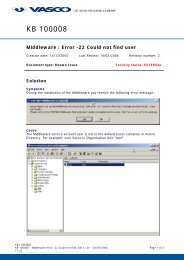

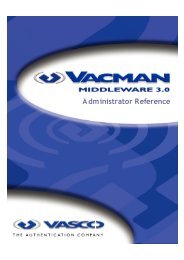
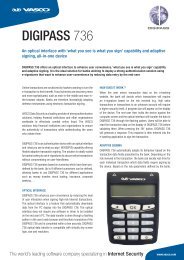
![KB [100006] - Vasco](https://img.yumpu.com/12539350/1/184x260/kb-100006-vasco.jpg?quality=85)

